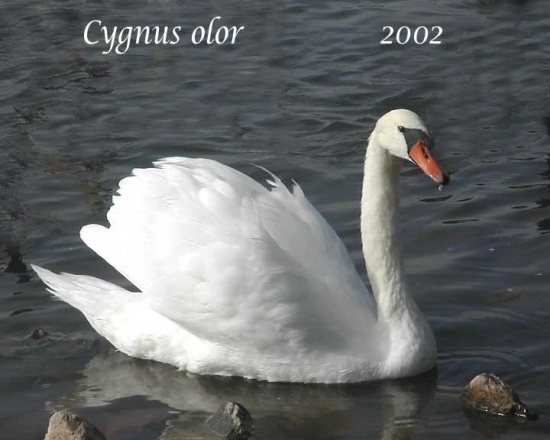(add another photo) |
|||
| Line 32: | Line 32: | ||
{{GSearch|Cygnus+olor}} | {{GSearch|Cygnus+olor}} | ||
| − | + | *[http://www.orientalbirdimages.org/birdimages.php?action=birdspecies&Bird_ID=168&Bird_Image_ID=1214&Bird_Family_ID=61 View more images of this species on Orientalbirdimages] | |
[[Category:Birds]] | [[Category:Birds]] | ||
Revision as of 06:07, 31 August 2007
- Cygnus olor
Description
Size: 127-152 cm (50-60 in); wingspan: 208-238 cm (82-94 in); weight: 5500-14300 g (12-31 lbs)
A large, white swan which often swims with it's wings arched and it's neck in an S-curve, giving it a very graceful appearance. It has a bright orange bill, with a black knob at the base. Male is larger than the female, with a larger knob on the bill. Young birds have dull, grayish-brown plumage and a gray bill without the knob.
Identification
Easily distinguished from other swans by it's distinctive orange and black bill.
Distribution
A native of northern and central Eurasia. It is a common resident throughout lowland British Isles, north and central France and east to Denmark and Germany. A summer visitor to southern Norway, southern Sweden and extreme south Finland, and Poland and the Baltic States. Also breeds around the northern shores of the Black and Caspian Seas and in parts of Turkey. In the west most are descended from introduced or feral birds and in Britain especially, live in close association with man. Bred ferally in Iceland in the 1960s but extinct since 1977.
Vagrant to Iceland and the Faroes, Morocco, Spain and the Canary Islands, Mediterranean islands and the Azores.
Birds found anywhere else in the world, have been intoduced as an ornamental species in parks and estates. In North America escaped birds have established feral populations in many areas, particularly around the Great Lakes and along the Atlantic coast. Their aggressive behaviour can threaten native waterfowl species and some states are trying to control the Mute Swan population.
Taxonomy
Habitat
In the west (Europe) found commonly in town parks, flooded gravel-pits and reservoirs and more natural wetlands. Much wilder birds in the east on slow-flowing rivers and large, shallow lakes, often in estuaries and on sheltered coasts out of the breeding season.
Behaviour
The Mute Swan mates for life, but if one of the pair should die, the other will remate. Is a very aggressive bird, especially during the breeding season. They feed on aquatic plants, by tipping up like a dabbling duck. Generally silent, but does make hissing and grunting noises.
External Links
Bird Song
<flashmp3>Cygnus olor (song).mp3</flashmp3>
Listen in an external program





